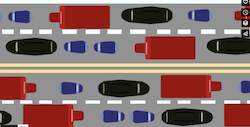SEJournal Online is the digital news magazine of the Society of Environmental Journalists. Learn more about SEJournal Online, including submission, subscription and advertising information.
 |
| A study of self-driving cars was the subject of an interdisciplinary study that brought a journalism educator together with fellow faculty from biology, journalism, communication, education, digital media and library science. Photo: Waymo. |
EJ Academy Opinion: Should Journalism Educators Mix It Up With Interdisciplinary Projects?
By Bob Wyss
Blue and red dots move on a screen, mimicking traffic on a busy highway. Two stick figures sit in what purports to be a traveling automobile. A landscape appears and a dotted line sweeps in a circle in the way a roller coaster would loop in an amusement park.
I am watching this two-minute animated video to consider the pros and cons of self-driving vehicles — produced by a digital media undergraduate working with an engineering graduate student — as part of an interdisciplinary teaching team.
But wait a minute. What is a journalism professor doing on this team and in this course?
You can find yourself in strange country when you agree to cross interdisciplinary lines at a university. Yet that’s what I did for several years when I joined such a teaching and research team.
Our primary focus was on helping mostly graduate and occasionally undergraduate students how to better communicate STEM (science, technology, engineering and math) issues. And our team consisted at times of faculty members from biology, journalism, communication, education, digital media and library science.
For journalism educators interested in working on such interdisciplinary efforts, I offer some of the benefits and challenges I learned in crossing academic boundaries.
Mix of backgrounds enhanced our efforts
Our team was created around 2015. Early on we decided to go for outside funding, and we were very lucky, winning a $500,000 National Science Foundation grant in our first major grant application. It is amazing how potential barriers fall by the wayside when you bring that kind of cash to the university.
The granters were clearly intrigued by our
diverse team of experts. Bringing together
a mixture of backgrounds at times enhanced
our ability to both teach and do research.
I don’t think any of us could do it by ourselves. The granters were clearly intrigued by our diverse team of experts. Bringing together a mixture of backgrounds at times enhanced our ability to both teach and do research.
For instance, one participant was from the university’s highly regarded School of Education; she guided us in developing every aspect of our course objectives and syllabi. Meanwhile, the digital media instructor offered a portion of the course helping students through an animation project. Another semester, a member of the university library staff (who happened to be the coordinator specializing in journalism) taught concepts in digital visualization.
Because we also promised to do research, we had some members who only worked on the research aspects. One was our communications member, who had a strong research background in social media, and who only worked on research even though social media was also an element in the teaching.
Crossing disciplines familiar to journalists
Those of us in journalism are perhaps somewhat more comfortable with reaching across academic boundaries to talk and collaborate with those in far different disciplines. Many of us did it for years as reporters.
Still, while universities often espouse the benefits of interdisciplinary efforts, academia is based on the concept of extreme specialization in both teaching and research. And while there are benefits in sharing, there are times it can be uncomfortable.
That animation video about self-driving vehicles was part of a graduate STEM communication course. I was teaching journalistic concepts for the team, so I tagged along on a separate portion dedicated to communicating through animation. While it was fascinating, my role had to be limited.
Meanwhile, my journalism colleagues always respected what I was doing while maintaining something of odd mixtures of wonder, skepticism and perhaps some indifference. And our department chair loved the financial payouts that came in, and she pretty much gave me free rein in what I taught.
While many of the major research grants
are outside of journalism, those of us teaching
journalism still do have some significant advantages.
While many of the major research grants are outside of journalism, those of us teaching journalism still do have some significant advantages. Increasingly, funders are requiring research grants to include a public engagement or outreach element so that information about the research goes beyond a select group of specialists. That’s what we do as journalists, and grant writers should be reminded of that and include more of us in both the funding and execution of their grants.
Some obstacles will emerge
I do suspect that winning the federal grant opened opportunities that otherwise would not have been available within my department. I mean that both as an invitation and a warning — this is not necessarily an easy path.
One barrier when you begin to defy university conventions has to do with where we met with students. There was no way under our university rules to create a class that mixed our diverse collection of graduate STEM students, undergraduates from journalism and digital media and the like.
 |
| A screenshot from an animated video on self-driving vehicles produced by an interdisciplinary academic team. Image: Courtesy the author. |
We had to have separate course numbers and they then had to be scheduled to meet at the same times. That worked, but the resulting classrooms were often too small, and we were always scrambling every semester to find available classroom space.
On the other hand, as an adjunct while I still worked for a newspaper and later when I was full-time, I had always taught undergraduates, so having an opportunity to teach graduate students from a totally different field — the STEM disciplines — was new, different and gratifying.
We taught close to 200 students and the framework of the graduate STEM communication courses have continued. But our grant was only for three years, which can go quickly. By the time it was over, two of us had retired, one had been promoted to full professor, another was awarded tenure.
We also published two extensive studies in science communication journals (one on science communication training and another on helping scientists communicate) and wrote a story about the research that ran in a national publication. Our interdisciplinary team continued to do research even after two of us retired, and we all communicated by Zoom, from posts coast to coast.
The bottom line for any fellow journalism educators who want to give interdisciplinary work a try: All of this can be a tremendous boon for anyone who is tenure track or anyone working to build an impressive and diversified portfolio. Universities may expect specialization, but it also does not hurt to be wide-ranging in what you can do.
For my part, this past summer we began to realize that the research was reaching a natural conclusion, and I know I’m going to miss meeting with such a diverse group of specialists.
Bob Wyss is the editor of the SEJournal’s EJ Academy column. A retired professor of journalism at the University of Connecticut, he now resides in Seattle.
* From the weekly news magazine SEJournal Online, Vol. 7, No. 37. Content from each new issue of SEJournal Online is available to the public via the SEJournal Online main page. Subscribe to the e-newsletter here. And see past issues of the SEJournal archived here.














 Advertisement
Advertisement 



